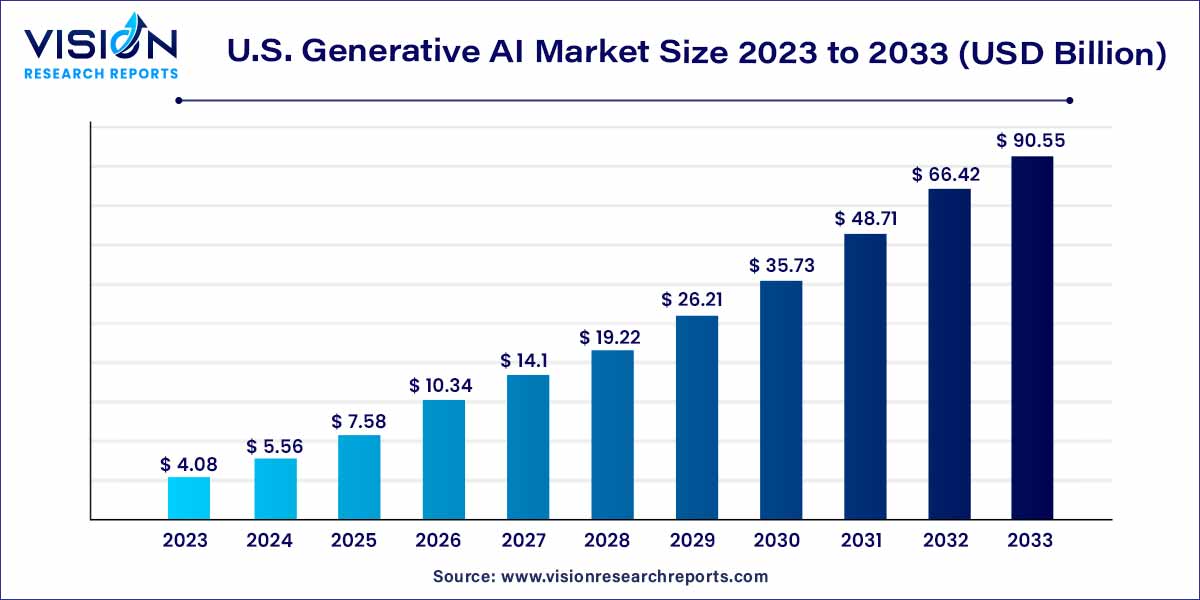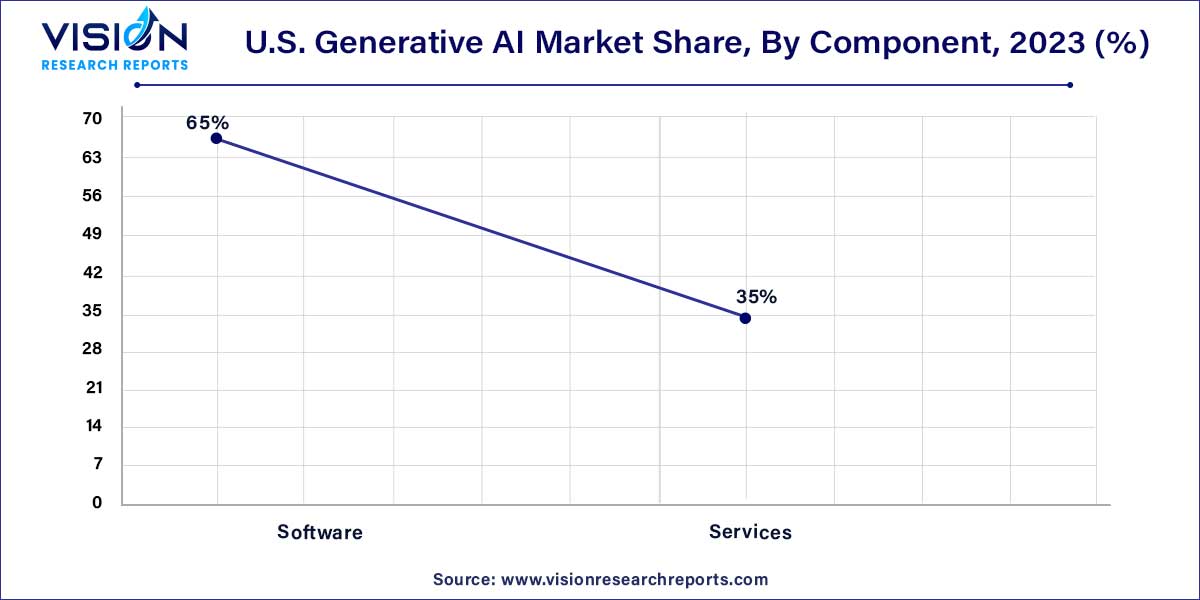The U.S. generative AI market size was estimated at USD 4.08 billion in 2023 and it is expected to surpass around USD 90.55 billion by 2033, poised to grow at a CAGR of 36.34% from 2024 to 2033. The U.S. generative AI market is driven by the escalating demand for automation across industries, increased investment, technological advancements, and businesses are leveraging generative ai to deliver personalized experiences to customers.

The U.S. generative AI market is witnessing rapid growth and innovation, driven by advancements in artificial intelligence technology and increasing demand across various industries. Generative AI, a subset of AI, involves systems that can autonomously produce content, images, or other data based on input or patterns learned from data. This overview explores the current landscape of the U.S. generative AI market, including key trends, drivers, challenges, and opportunities.
The growth of the U.S. generative AI market is propelled by several key factors. Firstly, rapid advancements in artificial intelligence technology, particularly in machine learning algorithms and deep learning architectures, are driving the development of more sophisticated generative AI models. These models can autonomously produce high-quality content, images, and data, catering to diverse industry needs. Additionally, the increasing demand for personalized experiences across various sectors, including healthcare, finance, marketing, and entertainment, is fueling the adoption of generative AI solutions. Businesses are leveraging these technologies to automate tasks, enhance creativity, and deliver tailored experiences to customers. Furthermore, the potential cost and time savings offered by generative AI, through automation of repetitive tasks and acceleration of product development cycles, are driving adoption among enterprises seeking efficiency gains. Overall, these growth factors signify a promising outlook for the U.S. generative AI market, with opportunities for innovation and transformative outcomes across industries.
Segmented by components, the market further breaks down into services and software. In 2023, the software segment claimed the largest revenue share, amounting to 65%, and is projected to maintain its dominance throughout the forecast period. The expansion of the software sector can be attributed to several factors, including the adoption of advanced technologies, increased investment in artificial intelligence, rising demand for automation, and favorable regulatory conditions. Moreover, the emergence of generative AI software is expected to significantly impact various sectors and industries such as manufacturing, gaming, and design.

Conversely, the service segment is poised to witness the fastest Compound Annual Growth Rate (CAGR) during the forecast period. This growth is fueled by escalating concerns over fraud detection, risk factor modeling, data protection, and trading prediction. Cloud-based generative AI services are anticipated to gain traction due to their scalability, flexibility, and cost-effectiveness, thereby propelling the segment's growth. For instance, in February 2024, S&P Global launched a generative AI search feature on the S&P Global Marketplace. This Global Solution for Marketplace Generative AI Search aims to streamline and enhance the exploration of S&P Global's offerings worldwide. By interpreting users' natural language queries and providing comprehensive responses, the platform improves the search experience. Furthermore, it takes proactive measures by suggesting additional relevant data sets and services, thereby broadening users' insights and options.
The market is categorized by technology into transformers, Generative Adversarial Networks (GANs), diffusion networks, and variational auto-encoders. The transformers segment held the largest revenue share in 2023, mainly due to the increasing adoption of transformer applications such as text-to-image AI, which converts text into images. Numerous companies are integrating text-to-image AI tools into their platforms to revolutionize the creation of visuals for projects, campaigns, and brands. For example, in January 2023, Shutterstock, Inc. launched its AI image generation platform, available in multiple languages, enabling prompt conversion into licensable visuals for its customers.
Additionally, the diffusion networks segment is projected to experience the fastest growth during the forecast period. Image synthesis has become vital across various industries including healthcare, automotive & transportation, defense, media & entertainment, BFSI, among others. This technology has empowered these industries to meet the increasing demands for image generation and deliver high-value services to businesses, government entities, and the general public.
The market is divided by end-use into media & entertainment, BFSI, IT & telecommunications, healthcare, automotive & transportation, and others. The "others" sub-segment includes security, aerospace & defense. In 2023, the media & entertainment segment held the largest market share and is anticipated to grow at a significant Compound Annual Growth Rate (CAGR) during the forecast period. The increasing adoption of generative AI for enhancing advertisement and campaign journalism is expected to drive demand for this technology in the media & entertainment industry. For example, in October 2023, Amazon Ads introduced a generative AI solution for image generation aimed at assisting advertisers in creating more engaging content and enhancing their ad campaigns.
On the other hand, the BFSI segment is projected to witness the fastest growth rate during the forecast period. This growth is attributed to simplifying complex data analysis, improving customer experiences, and enhancing risk management within the banking sector. Moreover, the BFSI industry has found generative AI valuable in generating marketing visuals and text, as well as enhancing the efficiency and accuracy of machine learning applications through data generation.
The Natural Language Processing (NLP) segment emerged as the market leader in 2023 and is forecasted to maintain significant growth momentum throughout the forecast period. Generative AI plays a pivotal role in advancing NLP processing by providing intricate prompts akin to human feedback. Furthermore, generative AI within NLP introduces advanced models and ethical considerations, fostering opportunities for applications in content summarization, sentiment analysis, and personalized user experiences.
Conversely, the computer vision segment is poised to experience the most rapid Compound Annual Growth Rate (CAGR) during the forecast period, driven by the escalating adoption of computer vision systems within the automotive and transportation sectors. Additionally, generative AI techniques empower computers to comprehend and manipulate visual data in unprecedented ways, including image inpainting, style transfer, and image-to-image translation, thereby unlocking novel applications in digital content creation, medical imaging, autonomous vehicles, and surveillance systems.
The large language model segment asserted its dominance in the market during 2023 and is forecasted to sustain substantial growth at a significant Compound Annual Growth Rate (CAGR) throughout the forecast period. Breakthroughs in neural network architectures, particularly transformer-based models like GPT, have facilitated the creation of large language models with millions, and even billions, of parameters. This advancement has notably enhanced their capacity to comprehend and generate text resembling human language across diverse contexts and domains. Such technological progressions have sparked heightened interest and investment in generative AI, propelling its rapid expansion and adoption across various applications.
Conversely, the multimodal generative model is poised to witness the fastest growth during the forecast period. Its capability to augment accuracy and resilience by amalgamating data from different modalities is a significant driver for its growth. This model type can achieve heightened performance by integrating information from multiple sources, thereby fueling its proliferation within the industry. Moreover, the segment of image and video models is anticipated to undergo substantial growth owing to its proficiency in swiftly producing high-quality and realistic images and videos. These outputs, often challenging or unattainable through conventional methods, are propelling the widespread adoption and advancement of this model type.
By Component
By Technology
By End-use
By Application
By Model
Chapter 1. Introduction
1.1. Research Objective
1.2. Scope of the Study
1.3. Definition
Chapter 2. Research Methodology
2.1. Research Approach
2.2. Data Sources
2.3. Assumptions & Limitations
Chapter 3. Executive Summary
3.1. Market Snapshot
Chapter 4. Market Variables and Scope
4.1. Introduction
4.2. Market Classification and Scope
4.3. Industry Value Chain Analysis
4.3.1. Raw Material Procurement Analysis
4.3.2. Sales and Distribution Channel Analysis
4.3.3. Downstream Buyer Analysis
Chapter 5. COVID 19 Impact on U.S. Generative AI Market
5.1. COVID-19 Landscape: U.S. Generative AI Industry Impact
5.2. COVID 19 - Impact Assessment for the Industry
5.3. COVID 19 Impact: Major Government Policy
5.4. Market Trends and Opportunities in the COVID-19 Landscape
Chapter 6. Market Dynamics Analysis and Trends
6.1. Market Dynamics
6.1.1. Market Drivers
6.1.2. Market Restraints
6.1.3. Market Opportunities
6.2. Porter’s Five Forces Analysis
6.2.1. Bargaining power of suppliers
6.2.2. Bargaining power of buyers
6.2.3. Threat of substitute
6.2.4. Threat of new entrants
6.2.5. Degree of competition
Chapter 7. Competitive Landscape
7.1.1. Company Market Share/Positioning Analysis
7.1.2. Key Strategies Adopted by Players
7.1.3. Vendor Landscape
7.1.3.1. List of Suppliers
7.1.3.2. List of Buyers
Chapter 8. U.S. Generative AI Market, By Component
8.1. U.S. Generative AI Market, by Component, 2024-2033
8.1.1. Software
8.1.1.1. Market Revenue and Forecast (2021-2033)
8.1.2. Services
8.1.2.1. Market Revenue and Forecast (2021-2033)
Chapter 9. U.S. Generative AI Market, By Technology
9.1. U.S. Generative AI Market, by Technology, 2024-2033
9.1.1. Generative Adversarial Networks (GANs)
9.1.1.1. Market Revenue and Forecast (2021-2033)
9.1.2. Transformers
9.1.2.1. Market Revenue and Forecast (2021-2033)
9.1.3. Variational auto-encoders
9.1.3.1. Market Revenue and Forecast (2021-2033)
9.1.4. Diffusion Networks
9.1.4.1. Market Revenue and Forecast (2021-2033)
Chapter 10. U.S. Generative AI Market, By End-use
10.1. U.S. Generative AI Market, by End-use, 2024-2033
10.1.1. Media & Entertainment
10.1.1.1. Market Revenue and Forecast (2021-2033)
10.1.2. BFSI
10.1.2.1. Market Revenue and Forecast (2021-2033)
10.1.3. IT & Telecommunication
10.1.3.1. Market Revenue and Forecast (2021-2033)
10.1.4. Healthcare
10.1.4.1. Market Revenue and Forecast (2021-2033)
10.1.5. Automotive & Transportation
10.1.5.1. Market Revenue and Forecast (2021-2033)
10.1.6. Gaming
10.1.6.1. Market Revenue and Forecast (2021-2033)
10.1.7. Others
10.1.7.1. Market Revenue and Forecast (2021-2033)
Chapter 11. U.S. Generative AI Market, By Application
11.1. U.S. Generative AI Market, by Application, 2024-2033
11.1.1. Computer Vision
11.1.1.1. Market Revenue and Forecast (2021-2033)
11.1.2. NLP
11.1.2.1. Market Revenue and Forecast (2021-2033)
11.1.3. Robotics and Automation
11.1.3.1. Market Revenue and Forecast (2021-2033)
11.1.4. Content Generation
11.1.4.1. Market Revenue and Forecast (2021-2033)
11.1.5. Chatbots and Intelligent Virtual Assistants
11.1.5.1. Market Revenue and Forecast (2021-2033)
11.1.6. Predictive Analytics
11.1.6.1. Market Revenue and Forecast (2021-2033)
11.1.7. Others
11.1.7.1. Market Revenue and Forecast (2021-2033)
Chapter 12. U.S. Generative AI Market, By Model
12.1. U.S. Generative AI Market, by Model, 2024-2033
12.1.1. Large Language models
12.1.1.1. Market Revenue and Forecast (2021-2033)
12.1.2. Image & Video generative models
12.1.2.1. Market Revenue and Forecast (2021-2033)
12.1.3. Multi-modal generative models
12.1.3.1. Market Revenue and Forecast (2021-2033)
12.1.4. Others
12.1.4.1. Market Revenue and Forecast (2021-2033)
Chapter 13. U.S. Generative AI Market, Regional Estimates and Trend Forecast
13.1. U.S.
13.1.1. Market Revenue and Forecast, by Component (2021-2033)
13.1.2. Market Revenue and Forecast, by Technology (2021-2033)
13.1.3. Market Revenue and Forecast, by End-use (2021-2033)
13.1.4. Market Revenue and Forecast, by Application (2021-2033)
13.1.5. Market Revenue and Forecast, by Model (2021-2033)
Chapter 14. Company Profiles
14.1. Google LLC
14.1.1. Company Overview
14.1.2. Product Offerings
14.1.3. Financial Performance
14.1.4. Recent Initiatives
14.2. Amazon Web Services, Inc.
14.2.1. Company Overview
14.2.2. Product Offerings
14.2.3. Financial Performance
14.2.4. Recent Initiatives
14.3. IBM
14.3.1. Company Overview
14.3.2. Product Offerings
14.3.3. Financial Performance
14.3.4. Recent Initiatives
14.4. Microsoft
14.4.1. Company Overview
14.4.2. Product Offerings
14.4.3. Financial Performance
14.4.4. Recent Initiatives
14.5. Hugging Face
14.5.1. Company Overview
14.5.2. Product Offerings
14.5.3. Financial Performance
14.5.4. Recent Initiatives
14.6. Cohere
14.6.1. Company Overview
14.6.2. Product Offerings
14.6.3. Financial Performance
14.6.4. Recent Initiatives
14.7. Tome.App
14.7.1. Company Overview
14.7.2. Product Offerings
14.7.3. Financial Performance
14.7.4. Recent Initiatives
14.8. AssemblyAI
14.8.1. Company Overview
14.8.2. Product Offerings
14.8.3. Financial Performance
14.8.4. Recent Initiatives
14.9. Midjourney
14.9.1. Company Overview
14.9.2. Product Offerings
14.9.3. Financial Performance
14.9.4. Recent Initiatives
14.10. Klaviyo
14.10.1. Company Overview
14.10.2. Product Offerings
14.10.3. Financial Performance
14.10.4. Recent Initiatives
Chapter 15. Research Methodology
15.1. Primary Research
15.2. Secondary Research
15.3. Assumptions
Chapter 16. Appendix
16.1. About Us
16.2. Glossary of Terms
 Cross-segment Market Size and Analysis for
Mentioned Segments
Cross-segment Market Size and Analysis for
Mentioned Segments
 Additional Company Profiles (Upto 5 With No Cost)
Additional Company Profiles (Upto 5 With No Cost)
 Additional Countries (Apart From Mentioned Countries)
Additional Countries (Apart From Mentioned Countries)
 Country/Region-specific Report
Country/Region-specific Report
 Go To Market Strategy
Go To Market Strategy
 Region Specific Market Dynamics
Region Specific Market Dynamics Region Level Market Share
Region Level Market Share Import Export Analysis
Import Export Analysis Production Analysis
Production Analysis Others
Others